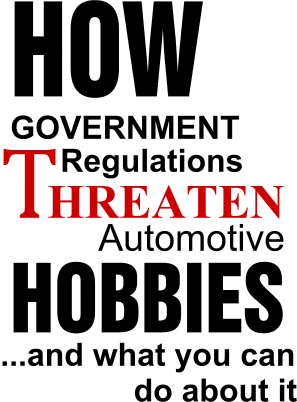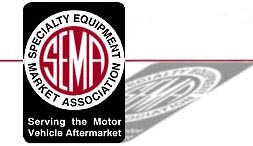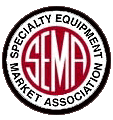

 |  |
 The New "Smog Test" |
 New-Vehicle Warranties |
 "Clunker"Programs |
 On-Board Diagnostic Systems |
 What To Do...Quickly | |
 THE NEW "SMOG TEST" |
Here we go again. What is it?
It's called "I/M 240", the "I/M" stands for inspection/maintenance.. So that you'll understand, it's similar to a "smog test" of the variety used in the past, but I/M 240 is a new and "improved" motor-vehicle inspection program that may be operating in your own state, or could be soon. I/M 240 was developed to test, measure and evaluate exhaust and evaporative emissions produced by late-model, high-technology vehicles. The Environmental Protection Agency (the EPA) says the old "smog test," known as a " two-speed idle test," is insufficient for this purpose.
What's the I/M 240 all about?
This test, as the name implies, requires a visual inspection of the emissions-control devices, as well as an "evaporative emissions test" and a "transient drive-cycle exhaust emissions test," all performed while the vehicle is running on rollers. It's much the same as having a car on a dyno, "running" on rollers. The test is very strict,; it is expected to take 20 to 30 minutes to complete, and it is designed to fail more vehicles. The failed vehicle will have to be repaired, or course, and then retested. Repairs, by the way, can be as high as $450 according to the regulation.
What's going to happen because of I/M 240?
As a result of I/M 240, you can expect to pay more for your smog check (the new inspection program), wait in long lines, pay more for repairs, and be the victim of "Big Brother" watching you: The "improved" I/M program requires on-road sensing devices that will pick up a vehicle's exhaust emissions. Owners of failed vehicles will receive a "mail summons" requiring them to submit their vehicles for inspection and testing. There's also a good possibility there will be more scrappage programs in certain parts of the country, crushing what the bureaucrats identify as "gross-polluting" vehicles, with no concern for repair, recycling or preserving antique and classic cars.
What you should do. Quickly.
Understand the "rules." Read other sections of this post. Get additional information whenever it is indicated in this post. If you're among the tens of thousand of vehicle owners who are unhappy about the I/M program, communicate with an elected representative and tell him or her how you feel. If you don't know who your elected reps are, look them up in the telephone company "Yellow Pages," or call city hall.

To aid you and other consumers like you in identifying after-market part that do not violate the anti tampering laws, manufacturers of parts and pieces have develped and published a voluntary identification program for emissions-sensitive products. Here are the easy to follow numeric/color symbols to guide you in proper purchase and use of emissions - sensitive products.
The law is clear: Simply because aftermarket equipment has been installed on a vehicle, the vehicle manufacturer cannot automatically void the warranty.



 NEW-VEHICLE WARRANTIES |
What's the lie?
A manufacturer's new-vehicle warranty is automatically voided once an aftermarket part (that means a part not put on or sold by the vehicle manufacture) is installed on the vehicle.
What's the truth?
Rarely does the use of a part that's not from the vehicle manufacturer violate a new-vehicle warranty. Period. Here's the only situation in which a warranty can be voided: If a vehicle owner installs a replacement part or accessory that isn't from the vehicle manufacturer, and either the installation of the product or the product itself is responsible for a problem that results in a warranty claim, the vehicle manufacturer is not responsible for the claim.
Okay. So it happens. What do it do?
If you have a disagreement with a vehicle dealer regarding a new-vehicle warranty claim, get a written explanation and letter of refusal from the dealer and consult your vehicle owner's manual for steps you should take. If the vehicle manufacturer also denies your claim, call the Federal Trade Commission (FTC) at 202-326-3128.
EMISSIONS-RELATED WARRANTIES
What's the lie?
Because federal law requires extended warranties of up to 8 years on a few pieces of emissions equipment, the vehicle owner must go to the new-vehicle dealer for service, rather than to an independent service provider.
What's the truth?
The law is very specific when it comes to where a vehicle owner can get a car or light truck serviced: at a place of the owner's choosing; there's nothing that says it has to be at a new-car dealership. Currently, about 70 percent of the parts, service and repairs to vehicles, late models included, is being done by independent garages and specialty shops. That tells us a lot about the public's preference for maintenance and repairs to their cars and light trucks.
OK. So I've got a problem with a dealer. What can I do?
If you have a disagreement with a vehicle dealer regarding an emissions-warranty claim, get a written explanation and letter of refusal from the dealer and consult your vehicle owner's manual for steps you should take. If the vehicle manufacturer also denies your claim, call the Environmental Protection Agency (EPA) for emissions-related problems at 202-233-9040, and also report your problem to the Federal Trade Commission (FTC) at 202-326-3128.
Two kinds of warranties
Federal law (the Clean Air Act) requires two emissions warranties: a "defect" warranty and a "performance" warranty. Here's some info on them so you'll know the difference.
Defect warranties require the vehicle manufacturer to produce a car or light truck which, at the time it is sold as a new vehicle, is free of defects that prevent it from meeting required emissions levels for its useful life, as defined in the law.
Performance warranties require the vehicle manufacturer to make repairs - at no cost to the owner - should the vehicle fail to meet certain levels of emissions performance during the warranty period. Depending on the vehicle model year, this warranty period can range from 2 years or 24,000 miles to 8 years or 80,000 miles for certain emissions-control components. (Check the owner's manual that came with the vehicle when it was new for specifics of the warranty.)
 "CLUNKER" PROGRAMS |
What's the lie about old-car buy back programs, also known as "clunker" regs?
That all old cars are "clunkers": poorly maintained, polluting vehicles that must be crushed to get 'em off the road.
And the truth?
The 10 to 20 percent of vehicles considered high polluters appear - consistently - in each and every model-year category of vehicles, not just in the pre-1981 model years that have been targeted by various old-car scrappage programs. Most polluters are statistically proven to be newer than the early 80's models.
Is there a danger in all this, to me, the hobbyist?
Be very alert to the following problems when a "clunker" regulation comes to your locality. By the way, they go by different names, so keep an eye out for "clunker" as indicated, as well as "old-car buy back programs" and "accelerated vehicle scrappage programs." They're cropping up all over, appearing in different parts of the U.S., the result of state regulations and those designed by local municipalities. Since the programs try to eliminate all cars by crushing them, these knee-jerk reactions by bureaucrats could forecast the end of your vehicle hobby, whatever form it takes, but particularly if it involves old cars.
By explanation: Here's how these programs are usually set up and how they benefit big industry, but at a high cost to the "little guy": you. Big oil companies and utilities get "mobile-source emission-reduction credits" for every vehicle scrapped in these programs (for which the company will pay $800 or so per vehicle). In return, that company is allowed to postpone cleaning up their own facilities to reduce what is called stationary-source emissions - in plain English that's smoke-stack pollution - for as long as 3 years. Meanwhile, you've possibly lost a car, or components, that could be used in a project. The car parts are gone forever, remember - they've been crushed beyond restoration..some aren't even recognizable. Sounds bad. What else? Are there other alternatives or options? On-board diagnostic systems, referred to as "OBD" and "OBD-II." are sophisticated computer-controlled monitoring systems in new cars and light-duty trucks. They are designed to monitor the vehicle's compliance with emission standards. Which cars are effected? What does it mean to me, an owner? What's the downside? And now, the truth about all this! This all sounds dangerous. Is it? The bottom line, please! If you're a hard-core gearhead or even what someone might call an interested bystander when it comes to cars and light-duty trucks, you're probably unhappy with the information brought to you on this site. To get changes made, you'll have to make your thoughts clear to those who have the power to defend your rights. Write letters to your state senator and state assembly representative (In Nebraska there's only a senator, no assemblyman). Senators and representatives are elected, and it is their responsibility to listen to you and act on your behalf. This said, you can see why there's strength in numbers. So get your friends, fellow hobbyists and motorsports enthusiasts and car-club members to do the same! To really get the attention of elected representatives, write to editors of local newspapers, car magazines and local radio and television stations, and tell them what's going on. They usually don't know, and when they find out (especially if they're car folks, too), it goes into print or is broadcast. That gets a lot of attention. Keep your letters brief. Simply state that, as a car owner and hobbyist, you strongly oppose any regulations that will eliminate your freedom to choose where you get automotive parts and service, and you are not going to stand by and let someone interfere with your ability to take part in, and maintain, the hobby of your choice. Cite the regulation or "law" you are opposing, such as "clunker" or OBD-II or...? Get this information out to anyone and everyone you can think of. If you have a WWW site, be sure to place a link to SEMA and this page. This information was taken from a pamphlet distributed by SEMA and posted as a public service to the Car Collectors of America by the Ford Galaxie Club of America
It is bad and there is another reason to be concerned. "Clunker" programs are voluntary today, but it is not unreasonable to suggest they could become mandatory - cast-in-stone law - in the future. Remember, these programs are very popular among bureaucrats who thrive on overregulation.
If you're reading this you know enough about cars to understand that there are alternatives to crushing old cars and light-duty trucks. Parts, and in many cases cars, can be recycled; and most parts can be rebuilt. Engines can be upgraded, even to include the installation of emissions-control retrofit devices. They shouldn't be crushed.

ON-BOARD DIAGNOSTICS
Vehicle manufacturers are required to phase in OBD-II systems on 1994 and 1995 model-year vehicles, with full compliance on 1996 and later model-year vehicles.
It means you can't do much of anything to your car; you might not be able to even change spark plugs, as an example. OBD systems are being designed to include an electronic lock on the vehicle electronic control module (that's another way of saying computer!) There are other "write-protected" features, meaning the computer contents can't be changed.
You're stuck. Need a repair? Take your new car (or light truck) back to the dealer. You can't fix it yourself, and an independent garage can't make any adjustments, repairs or modifications as the system is now designed. The new-car dealer has to "plug in" your vehicle, and electronic equipment will "read" the vehicle computer. Uh. Sorry. It'll read the "electronic control module."
Hobbyists are devastated now that they understand that no changes or modifications can be made without causing a malfunction indicator light to com on. (Be the first to know that the warning light is called a "MIL" for "malfunction indicator light." You can be "one up" on your fellow car-club members at the next meeting.) The Clean Air Act preserves your rights to make a choice about where you have your car serviced or repaired. It is in the interest of the public's freedom that the Clean Air Act makes that provision. You're supposed to have the right to choose between the new-car dealer and an independent repair garage for service.
It's government regulation unlike anything we've ever heard about or seen in motor vehicles in the past. OBD-II appears to give new-car dealers a monopoly. OBD-II may eliminate your ability to install performance products, certain wheels and tires, suspension components and ground-effects kits due to additional engine loading, vibration or aerodynamic effects. The items listed here could could cause the MIL to illuminate. And, here's the scariest part: Anti tampering requirements, as a part of the OBD-II regulations, may make legitimate computer reprogramming impossible.
The vehicle owner loses the freedom to purchase replacement parts where he or she chooses - parts will have to come from the new-car dealer, and the prices could be much higher than the corner parts store, as everyone knows. Further, forget add-on performance gear and related modifications. As the OBD-II regs now stand, you won't be able to do much of anything to improve performance. Even an updated "look" to "your ride" may be in question, since the upgraded tires and wheels might illuminate the MIL, as could ground-effects pieces and other add-ons.



Serving the Motor
Vehicle AftermarketThe preceding information
is brought to you as a
public service by SEMA,
the Specialty Equipment
Market Association.
Copies of a printed version of
this flyer are available for car
clubs, swap meets etc. For more detailed information, E-mail us at:
sema@sema.org
For continual update on proposed Federal Regulations
Go to: http://www.sema.org/consumer/fedleg/